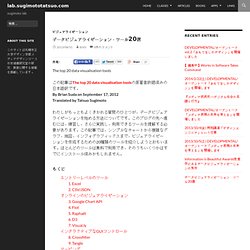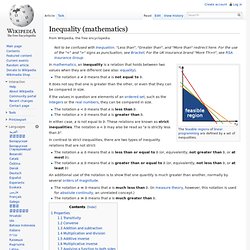

データビジュアライゼーション・ツール20選. この記事はThe top 20 data visualisation toolsの原著者許諾済みの日本語訳です。

By Brian Suda on September 17, 2012 Translated by Tatsuo Sugimoto わたしがもっともよくきかれる質問のひとつが、データビジュアライゼーションを始める方法についてです。 このブログの先へ進むには、練習し、さらに実践し、利用できるツールを理解する必要があります。 この記事では、シンプルなチャートから複雑なグラフ、地図、インフォグラフィックスまで、ビジュアライゼーションを作成するための20種類のツールを紹介しようとおもいます。 ほとんどのツールは無料で利用でき、そのうちいくつかはすでにインストール済みかもしれません。 もくじ エントリーレベルのツール エントリーレベルでは、使いなれたツールを転用してみましょう。 1. セルの「ヒートマップ」から散布図まで、Excelではかなり複雑なことができます。 Excelは、商用のMicrosoft Officeの一部として提供されていますので、購入していない場合は、Googleドライブの一部であるGoogleスプレッドシートでほぼ同じことができます。 CSV(コンマ区切り値)とJSON(JavaScript Object Notation)は、ビジュアライゼーションツールではありませんが、一般的なデータフォーマットです。
オンラインのビジュアライゼーション 3. 静的画像のためのツールセットの一部が廃止されたため、現在Google Chart Toolsサイトは動的なチャートのためのツールだけを提供しています。 とはいえこのAPIは、棒グラフ、折れ線グラフから地図やQRコードにいたるまで、ありとあらゆることができます。 4. Flotは、折れ線グラフと棒グラフ用のすばらしいライブラリです。 Flotの素晴らしい点は、多くのコールバック関数にアクセスできるので、ユーザーのホバー、クリック、マウスアウトなどの一般的なイベント発生時に、独自のコードとスタイルを実行できることです。 5. Raphaëlもグラフ作成のすばらしいJavaScriptライブラリです。
D3 (Data-Driven Documents)は、SVGレンダリングをサポートするJavaScriptライブラリです。 7. 8. Gilbert Strang's Home Page. Forbidden graph characterization. Such forbidden structures can also be called obstruction sets.

Forbidden graph characterizations are utilized in combinatorial algorithms, often for identifying a structure. Such methods can provide a polynomial-time algorithm for determining a graph's membership in a specific family (i.e., a polynomial-time implementation of an indicator function). A well-known characterization of this kind is Kuratowski's theorem that provides two forbidden homeomorphic subgraphs, using which, one may determine a graph's planarity. Another is the Robertson–Seymour theorem that proves the existence of a forbidden minor characterization for several graph families. List of forbidden characterizations for graphs and hypergraphs[edit] See also[edit] References[edit] Inequality (mathematics) Not to be confused with Inequation.

"Less than", "Greater than", and "More than" redirect here. For the use of the "<" and ">" signs as punctuation, see Bracket. For the UK insurance brand "More Th>n", see RSA Insurance Group. The notation a ≠ b means that a is not equal to b. It does not say that one is greater than the other, or even that they can be compared in size. If the values in question are elements of an ordered set, such as the integers or the real numbers, they can be compared in size. The notation a < b means that a is less than b.The notation a > b means that a is greater than b. In either case, a is not equal to b. In contrast to strict inequalities, there are two types of inequality relations that are not strict: The notation a ≤ b means that a is less than or equal to b (or, equivalently, not greater than b, or at most b).The notation a ≥ b means that a is greater than or equal to b (or, equivalently, not less than b, or at least b)
Convex Optimization I (Stanford) Example of pseudometric space.
Stats. Sage - Tour. Sage is built out of nearly 100 open-source packages and features a unified interface.

Sage can be used to study elementary and advanced, pure and applied mathematics. This includes a huge range of mathematics, including basic algebra, calculus, elementary to very advanced number theory, cryptography, numerical computation, commutative algebra, group theory, combinatorics, graph theory, exact linear algebra and much more. It combines various software packages and seamlessly integrates their functionality into a common experience. It is well-suited for education and research. The user interface is a notebook in a web browser or the command line. The following showcase presents some of Sage's capabilities, screenshots and gives you an overall impression of what Sage is.
Sage: Open Source Mathematics Software.
OR. ML.